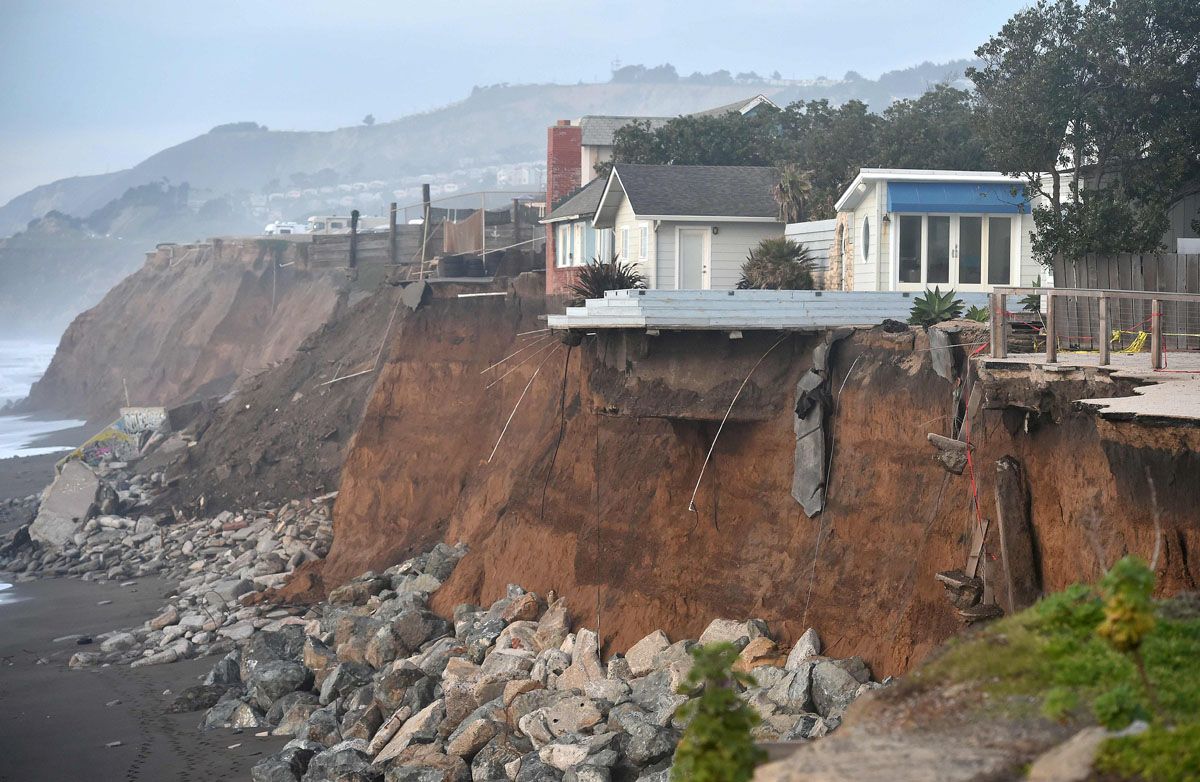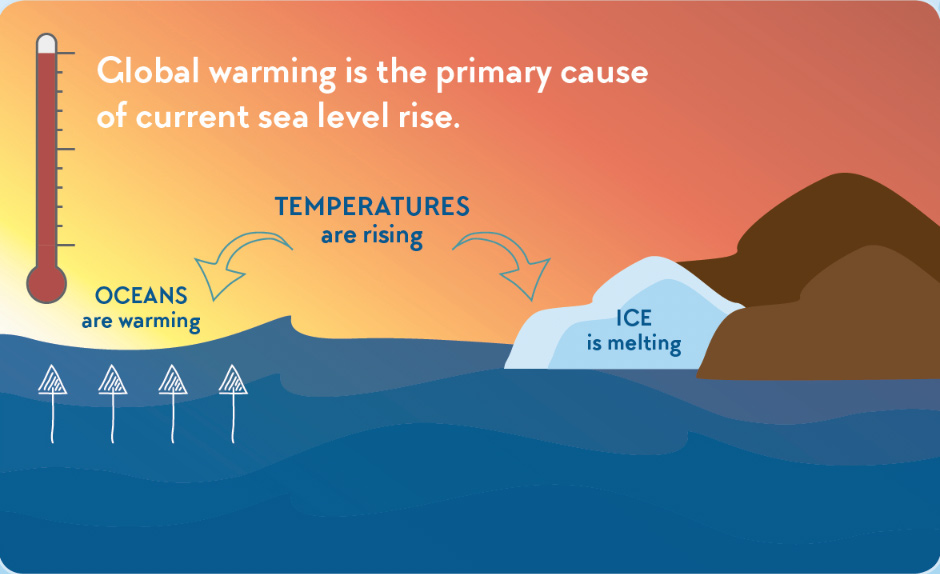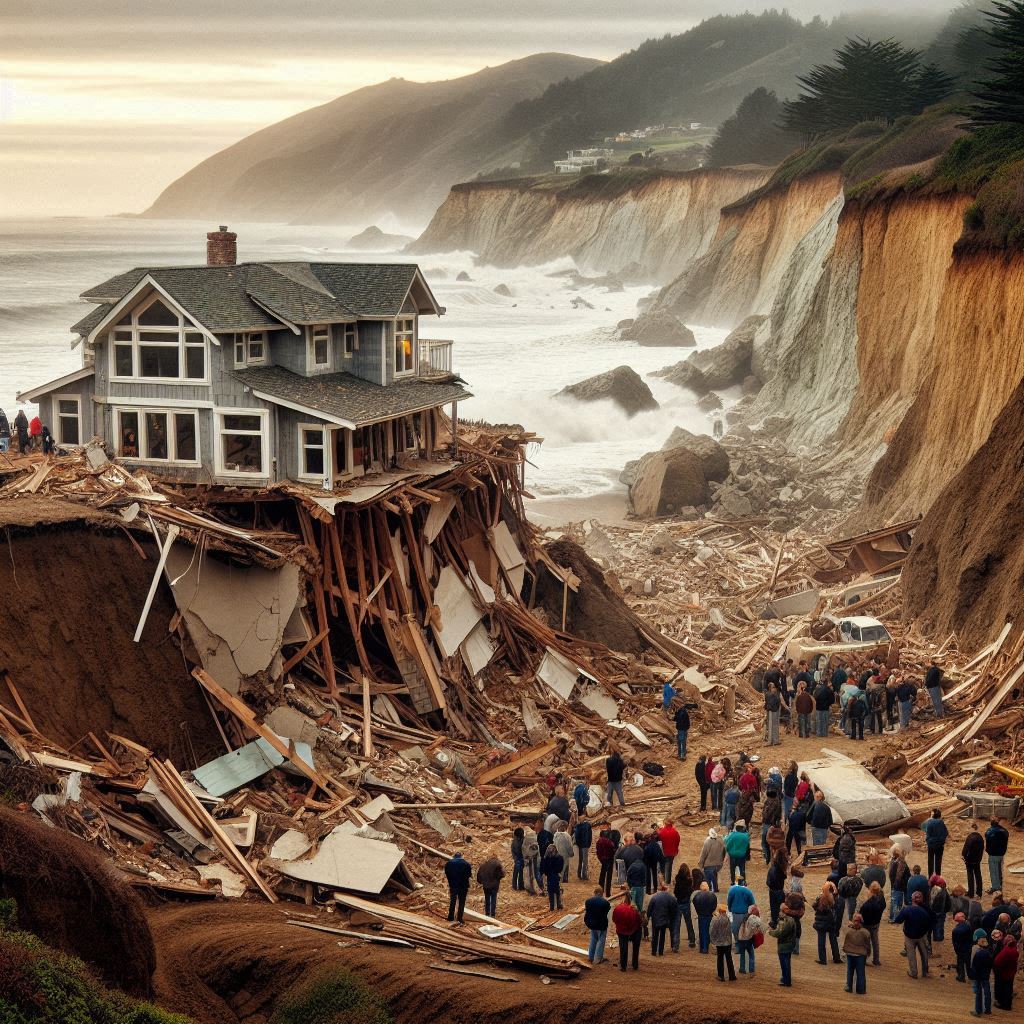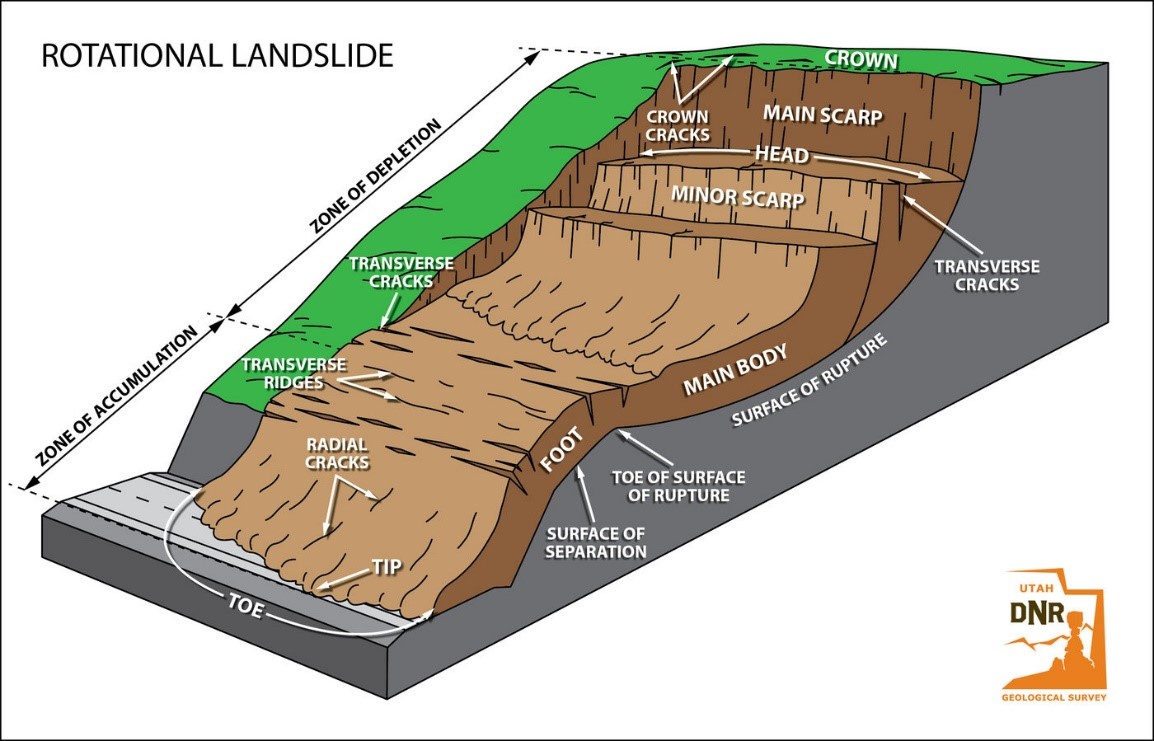
Watch short for this article (5 slides)
The Crumbling Coastline: How Climate Change Intensifies Landslide Risks in California
California's stunning coastline, a symbol of natural beauty and desirable living, is facing an escalating threat: landslides. While cliff erosion and slope failures are natural geological processes, mounting evidence indicates that climate change is acting as a powerful accelerant, increasing the frequency and severity of these events. Intensifying storms delivering torrential rainfall, relentless sea-level rise undercutting coastal bluffs, and devastating wildfires stripping slopes bare are converging to destabilize land, endangering homes, infrastructure, and lives. This article delves into the specific mechanisms through which climate change exacerbates landslide risks along California's coast and explores the complex mitigation and adaptation strategies required to address this growing hazard.

Understanding Coastal Landslides: More Than Just Falling Rocks
Landslides encompass a range of ground movements down a slope under the influence of gravity. Along coastlines, common types include:
- Slides (Rotational/Translational): Where a distinct block of soil or rock moves downslope along a defined failure surface. Rotational slides involve a curved surface, often creating scarps at the top and bulging toes at the bottom. Translational slides move along a planar surface.
- Flows (Debris Flows/Mudflows): Rapidly moving mixtures of water, soil, rock, and vegetation, often channeled down valleys or gullies. These are particularly dangerous due to their speed and destructive power, often triggered by intense rainfall on saturated or wildfire-denuded slopes.
- Falls/Topples: Abrupt movements of rocks and boulders detaching from steep cliffs or slopes, primarily driven by weathering and undercutting.
The stability of any slope depends on a balance between the driving forces (gravity acting on the mass of soil/rock) and the resisting forces (the shear strength of the material, root reinforcement, buttressing at the base). Climate change is systematically weakening these resisting forces along California's coast.
The Climate Change Accelerant: Key Factors Amplifying Landslide Risk

1. Intensified Precipitation Patterns: Atmospheric Rivers and Soil Saturation
California's precipitation regime is becoming increasingly characterized by "climate whiplash" – long dry periods punctuated by short, extremely intense rainfall events, often delivered by **Atmospheric Rivers (ARs)**. These potent storms transport vast amounts of moisture from the tropics.
- Mechanism of Failure: Intense, prolonged rainfall saturates soils on slopes. This saturation dramatically increases **pore water pressure** – the pressure of water within the spaces between soil particles. Elevated pore water pressure effectively pushes particles apart, significantly reducing the soil's internal friction and shear strength (its ability to resist sliding). Once the driving force of gravity exceeds the weakened resisting forces, failure occurs.
- Rainfall Thresholds: The U.S. Geological Survey (USGS) develops rainfall thresholds for specific areas, indicating the rainfall intensity and duration likely to trigger debris flows, particularly after wildfires. Climate change, by increasing the frequency of extreme AR events, means these thresholds are being met more often.
- Drought-Flood Cycle Impact: Prolonged droughts, also linked to climate change, can make soils hydrophobic (water-repellent) initially, increasing surface runoff. However, once saturation occurs during intense rain, the previously dried and potentially cracked soils can fail dramatically.
2. Sea-Level Rise: Undercutting Coastal Defenses
Global warming causes sea levels to rise through thermal expansion of ocean water and melting of glaciers and ice sheets. California is experiencing accelerating sea-level rise.
- Mechanism of Failure: Higher sea levels allow waves, especially during storms and high tides (King Tides), to reach higher elevations and attack the base of coastal cliffs and bluffs more frequently and with greater energy. This **undercutting** removes support from the base of the slope, steepening it and making the upper portions prone to collapse or sliding.
- Beach Erosion: Rising seas also contribute to the narrowing or disappearance of protective beaches, which normally act as natural buffers absorbing wave energy. Without beaches, wave energy directly impacts the cliffs.
- Groundwater Effects: Rising sea levels can also elevate coastal groundwater tables, potentially increasing soil saturation and pore water pressure from below, further destabilizing cliffs. (NOAA Sea Level Rise Projections indicate significant future increases.)
3. Wildfire Impacts: Removing Nature's Anchors
Climate change contributes to hotter, drier conditions, increasing the frequency, size, and intensity of wildfires across California, including near coastal areas.
- Mechanism of Failure: Wildfires devastate vegetation, which plays a critical role in slope stability.
- Loss of Root Strength: Plant roots act like a binding mesh, holding soil particles together and increasing shear strength. Intense fires kill plants and consume roots, eliminating this reinforcement.
- Increased Runoff & Erosion: The loss of vegetation cover and protective leaf litter exposes bare soil to direct raindrop impact and allows runoff to flow unimpeded, leading to surface erosion and the formation of rills and gullies.
- Altered Soil Properties: Intense heat can create a water-repellent (hydrophobic) layer near the soil surface, further increasing runoff during initial rainfall. It can also damage soil structure.
"We're seeing a dangerous convergence. Climate change drives more intense wildfires that burn steeper slopes, followed by more intense atmospheric rivers. This significantly elevates the risk of catastrophic post-fire debris flows impacting communities downslope." - Paraphrased synthesis of warnings from USGS and CAL FIRE experts.
The Human Toll: Impacts on Coastal Communities

The consequences of increased landslide activity are far-reaching and costly:
- Property Loss and Damage: Homes, particularly high-value properties built on coastal bluffs or near steep slopes (e.g., in areas like Big Sur, Malibu, Palos Verdes Peninsula, Laguna Beach), are increasingly vulnerable to damage or complete destruction.
- Infrastructure Disruption: Major transportation routes like Highway 1 are frequently closed due to landslides, isolating communities and impacting tourism and commerce. Damage to roads, bridges, utility lines (water, sewer, power, communications), and public facilities requires expensive and often recurring repairs.
- Insurance and Financial Strain: Obtaining and affording insurance for properties in landslide-prone areas is becoming increasingly difficult. Premiums are rising, coverage may be limited (standard homeowner policies often exclude earth movement), and some insurers are withdrawing from high-risk zones, forcing homeowners into state-backed FAIR plans or self-insurance. Property values can plummet.
- Safety Risks and Evacuations: Landslides pose a direct threat to life. Evacuations may be necessary during intense storms or after wildfires, causing significant disruption and stress for residents.
- Ecological Damage: Landslides can damage coastal habitats, smother marine environments with sediment, and impact water quality.
Building Resilience: Mitigation and Adaptation Strategies

Addressing the escalating risk requires a multi-pronged approach combining engineering, planning, restoration, and monitoring:
1. Geotechnical Engineering and Reinforcement
Structural measures can help stabilize specific slopes, though they are often expensive and may have environmental impacts:
- Retaining Structures: Walls built at the base of slopes (e.g., gravity walls, cantilever walls, anchored walls, soil nail walls) to resist downslope movement.
- Coastal Armoring: Seawalls, revetments (sloped structures often made of rock or concrete), or riprap placed at the cliff base to absorb wave energy and prevent undercutting. (Note: These can accelerate erosion on adjacent, unarmored sections and often lead to beach loss in front of the structure).
- Slope Modification: Regrading slopes to a gentler angle, terracing, or removing unstable material at the top (unloading).
- Drainage Improvements: Installing surface drains (ditches, culverts) and subsurface drains (horizontal drains, dewatering wells) to intercept runoff and reduce pore water pressure within the slope.
- Soil Reinforcement: Techniques like soil nailing (installing passive steel bars into the slope) or using geosynthetic materials to improve soil strength.
- Shotcrete: Spraying concrete onto a slope face to prevent surface erosion and weathering, often used with soil nails or anchors.
2. Land-Use Planning and Policy
Preventing development in hazardous areas is often the most effective long-term strategy:
- Hazard Mapping and Zoning: Utilizing detailed geological hazard maps (like those produced by the California Geological Survey) to inform zoning regulations that restrict or prohibit construction in high-risk landslide or coastal erosion zones (e.g., implementing mandatory setbacks from cliff edges).
- Stricter Development Standards: Requiring thorough geotechnical investigations and incorporating robust engineering designs for any development permitted in potentially unstable areas. Regulating grading, drainage, and vegetation removal during construction.
- Managed Retreat: In some highly vulnerable areas, planning for the relocation of structures and infrastructure further inland may be the most sustainable, albeit socially and economically challenging, option over the long term.
3. Vegetation Management and Ecological Restoration
Using vegetation to enhance slope stability:
- Planting Native, Deep-Rooted Species: Establishing appropriate native vegetation can significantly increase soil shear strength through root reinforcement and reduce surface erosion.
- Post-Fire Erosion Control: Implementing emergency measures after wildfires, such as hydroseeding, installing straw wattles or erosion control blankets, and constructing check dams, to minimize immediate runoff and erosion before vegetation recovers.
4. Monitoring and Early Warning Systems
Advanced technology helps anticipate and warn of potential failures:
- Rainfall Threshold Monitoring: USGS and NOAA issue debris flow warnings based on real-time rainfall data and established thresholds for burn scars.
- Remote Sensing: Technologies like LiDAR (Light Detection and Ranging) and InSAR (Interferometric Synthetic Aperture Radar) can detect subtle ground deformation over time, indicating potential instability.
- Ground-Based Monitoring: Installing instruments like piezometers (measure pore water pressure), inclinometers (measure slope movement), and extensometers (measure ground cracking) on critical slopes.
Conclusion: Adapting to an Unstable Future
The link between climate change and the increasing frequency and severity of coastal landslides in California is clear and concerning. Intensified rainfall, rising sea levels, and more frequent, severe wildfires are creating conditions ripe for slope failure, putting communities and infrastructure at significant risk. While engineering solutions can offer localized protection, a comprehensive strategy must also prioritize informed land-use planning, ecological restoration, advanced monitoring, and, ultimately, global efforts to mitigate the root cause – climate change itself. Building resilience along California's dynamic coastline requires acknowledging these amplified risks and making difficult, science-based decisions to adapt to a less stable future.